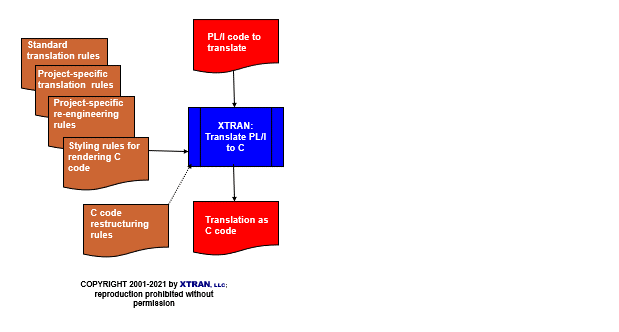XTRAN Example — Translate PL/I Calling Arguments to C
The following example uses the standard set of XTRAN rules for parsing PL/I and translating it to C. NOTE that the translation shown below was done with default conditions. XTRAN provides many options for controlling the way it translates.
Process Flowchart
Here is a flowchart for this process, in which the elements are color coded:
- BLUE for XTRAN versions (runnable programs)
- ORANGE for XTRAN rules (text files)
- RED for
code - PURPLE for text data files

Input to XTRAN:
DCL subr1 ENTRY; /*DCL subr1 ENTRY;*/
DCL subr2 ENTRY (BINARY FLOAT(6), /*DCL subr2 ENTRY (BINARY FLOAT(6),*/
BINARY FIXED(31), /*BINARY FIXED(31),*/
BINARY FLOAT(6)); /*BINARY FLOAT(6));*/
DCL subr3 ENTRY (BINARY FIXED(31), /*DCL subr3 ENTRY (BINARY FIXED(31),*/
BINARY FLOAT(6)); /*BINARY FLOAT(6));*/
DCL subr4 ENTRY (BINARY FLOAT(6), /*DCL subr2 ENTRY (BINARY FLOAT(6),*/
BINARY FLOAT(6)); /*BINARY FLOAT(6));*/
DCL func1 ENTRY (BINARY FIXED(31), /*DCL func1 ENTRY (BINARY FIXED(31),*/
BINARY FLOAT(6)) /*BINARY FLOAT(6))*/
RETURNS (BINARY FIXED(31)); /*RETURNS (BINARY FIXED(31));*/
DCL func2 ENTRY (BINARY FLOAT(6), /*DCL func2 ENTRY (BINARY FLOAT(6),*/
BINARY FIXED(31)) /*BINARY FIXED(31))*/
RETURNS (BINARY FIXED(31)); /*RETURNS (BINARY FIXED(31));*/
proc1: PROCEDURE;
CALL subr1; /*CALL subr1;*/
CALL subr2( /*CALL subr2(*/
a + 1.0, /*a + 1.0,*/
func1(b, c + func2(d, 3)), /*func1(b, c + func2(d, 3)),*/
e); /*e);*/
CALL subr3(1, a); /*CALL subr3(1, a);*/
CALL subr4(a, b); /*CALL subr4(a, b);*/
END proc1;
Output from XTRAN:
double subr1(void); /*DCL subr1 ENTRY;*/
double subr2(double *, long *,
double *); /*DCL subr2 ENTRY (BINARY FLOAT(6),*/
/*binary fixed(31),*/
/*binary float(6));*/
double subr3(long *, double *); /*DCL subr3 ENTRY (BINARY FIXED(31),*/
/*binary float(6));*/
double subr4(double *, double *); /*DCL subr2 ENTRY (BINARY FLOAT(6),*/
/*binary float(6));*/
long func1(long *, double *); /*DCL func1 ENTRY (BINARY FIXED(31),*/
/*binary float(6))*/
/*returns (binary fixed(31));*/
long func2(double *, long *); /*DCL func2 ENTRY (BINARY FLOAT(6),*/
/*binary fixed(31))*/
/*returns (binary fixed(31));*/
double proc1(void)
{
double a;
double b;
double c;
double d;
double e;
subr1(); /*CALL subr1;*/
{
int f3_a2 = 3;
double f2_a2 = c + func2(&d, &f3_a2);
double f1_a1 = a + 1.0;
long f1_a2 = func1(&b, &f2_a2);
subr2(&f1_a1, &f1_a2, &e); /*CALL subr2(*/
/*a + 1.0,*/
/*func1(b, c + func2(d, 3)),*/
/*e);*/
}
{
int f1_a1 = 1;
subr3(&f1_a1, &a); /*CALL subr3(1, a);*/
}
subr4(&a, &b); /*CALL subr4(a, b);*/
}